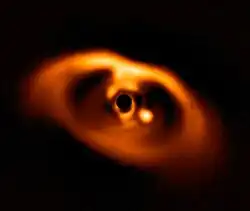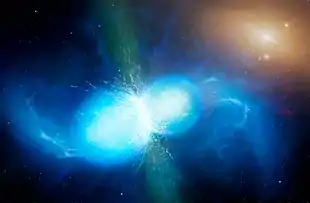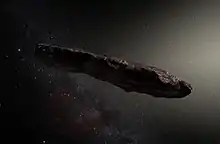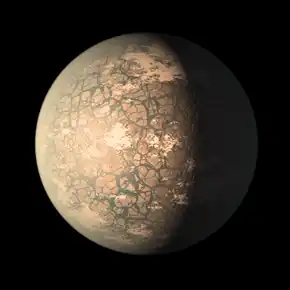 Artist's impression of TRAPPIST-1f. (February 2018) | |
| Discovery[1] | |
|---|---|
| Discovered by | Michaël Gillon et al. |
| Discovery site | Spitzer Space Telescope |
| Discovery date | 22 February 2017 |
| Transit | |
| Orbital characteristics[2] | |
| 0.03849±0.00033 AU | |
| Eccentricity | 0.01007±0.00068[3] |
| 9.207540±0.000032 d | |
| Inclination | 89.740°±0.019° |
| 368.81°±3.11°[3] | |
| Star | TRAPPIST-1 |
| Physical characteristics[2] | |
Mean radius | 1.045+0.013 −0.012 R🜨 |
| Mass | 1.039±0.031 M🜨 |
Mean density | 5.009+0.138 −0.158 g/cm3 |
| 0.951±0.024 g 9.32±0.24 m/s2 | |
| Temperature | Teq: 217.7±2.1 K (−55.5 °C; −67.8 °F)[4] |
TRAPPIST-1f, also designated as 2MASS J23062928-0502285 f, is an exoplanet, likely rocky,[2] orbiting within the habitable zone[5] around the ultracool dwarf star TRAPPIST-1, located 40.7 light-years (12.5 parsecs) away from Earth in the constellation of Aquarius. The exoplanet was found by using the transit method, in which the dimming effect that a planet causes as it crosses in front of its star is measured.
It was one of four new exoplanets to be discovered orbiting the star in 2017 using observations from the Spitzer Space Telescope.[1]
The planet is likely tidally locked, and has been depicted as an eyeball planet in artistic impressions by NASA.
Physical characteristics
Mass, radius, and temperature
TRAPPIST-1f is an Earth-sized exoplanet, meaning it has a radius close to that of Earth. It has an equilibrium temperature of 218 K (−55 °C; −67 °F).[4] It has a radius of 1.045 R🜨 and a mass of 1.039 M🜨.[2] It was initially estimated to have a much lower mass, and thus a low density of 3.3±0.9 g/cm3 and a surface gravity around 6.1 m/s2 (62% of Earth's value).[1] This suggested a large amount of volatiles, with a 2017 study suggesting that a water ocean may comprise as much as 20% of the planet's mass, increasing the temperature at the bottom of such an ocean to above 1,400 K (1,130 °C; 2,060 °F).[6] However, refined density estimates show that TRAPPIST-1f, like other planets in the system, is only slightly less dense than Earth, consistent with a rocky composition.[2]
Atmosphere
According to simulations of magma ocean-atmosphere interaction, TRAPPIST-1f is likely to retain a fraction of primordial steam atmosphere during the initial stages of evolution, and therefore today is likely to possess a thick ocean covered by atmosphere rich in abiotic oxygen.[7] Helium emission from TRAPPIST-1f (and planets b and e) has not been detected as of 2022.[8]
Host star
The planet orbits an (M-type) ultracool dwarf star named TRAPPIST-1. The star has a mass of 0.08 M☉ and a radius of 0.11 R☉. It has a temperature of 2550 K and is at least 7-8 billion years old. In comparison, the Sun is 4.6 billion years old[9] and has a temperature of 5778 K.[10] The star is metal-rich, with a metallicity ([Fe/H]) of 0.04, or 109% the solar amount. This is particularly odd as such low-mass stars near the boundary between brown dwarfs and hydrogen-fusing stars should be expected to have considerably less metal content than the Sun; on the other hand, metal-rich stars are also more likely to have planets than metal-poor ones. Its luminosity (L☉) is 0.05% of that of the Sun.
The star's apparent magnitude, or how bright it appears from Earth's perspective, is 18.8. Therefore, it is too dim to be seen with the naked eye.
Orbit
TRAPPIST-1f orbits its host star with an orbital period of about 9.206 days and an orbital radius of about 0.037 times that of Earth's (compared to the distance of Mercury from the Sun, which is about 0.38 AU).
Habitability
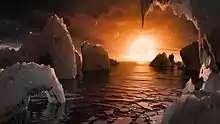
The exoplanet was announced to be either orbiting within or slightly outside of the habitable zone of its parent star, the region where, with the correct conditions and atmospheric properties, liquid water may exist on the surface of the planet. On 31 August 2017, astronomers at the Hubble Space Telescope reported the first evidence of possible water content on the TRAPPIST-1 exoplanets.[11][12]
TRAPPIST-1f has a radius about the same as Earth, at around 1.045 R🜨, but was initially thought to have only about two thirds of Earth's mass, at around 0.68 MEarth. So, it was considered somewhat unlikely to be a fully rocky planet, and extremely unlikely to be an Earth-like one, that is rocky with a large iron core but without a thick hydrogen-helium atmosphere enveloping the planet. Simulations in 2017 suggested the planet is approximately 20% water by composition, much higher than that of Earth. With such a massive water envelope, the pressure and temperature will be high enough to keep the water in a gaseous state and any liquid water will only exist as clouds near the top of TRAPPIST-1f's atmosphere. Based on this study, TRAPPIST-1f is therefore likely to be no more habitable than any other ice giant with water clouds in its atmosphere.[6] However, refined estimates show that TRAPPIST-1f has about the same mass as Earth, and like other planets in the system, is only slightly less dense than Earth, consistent with a rocky composition.[2]
Its host star is a red ultracool dwarf, with only about 8% of the mass of the Sun (close to the boundary between brown dwarfs and hydrogen-fusing stars). As a result, stars like TRAPPIST-1 have the ability to live up to 4–5 trillion years, 400–500 times longer than the Sun will live.[13] Because of this ability to live for long periods of time, it is likely TRAPPIST-1 will be one of the last remaining stars when the Universe is much older than it is now, when the gas needed to form new stars will be exhausted, and the remaining ones begin to die off.
The planet is very likely tidally locked, with one hemisphere permanently facing towards the star, while the opposite side shrouded in eternal darkness. However, between these two intense areas, there would be a sliver of moderate temperature – called the terminator line, where the temperatures may be suitable (about 273 K or 0 °C or 32 °F) for liquid water to exist. Additionally, a much larger portion of the planet may be habitable if it supports a thick enough atmosphere to transfer heat to the side facing away from the star.
See also
References
- 1 2 3 Gillon, Michaël; Triaud, Amaury H. M. J.; Demory, Brice-Olivier; Jehin, Emmanuël; Agol, Eric; Deck, Katherine M.; Lederer, Susan M.; Wit, Julien de; Burdanov, Artem (2017). "Seven temperate terrestrial planets around the nearby ultracool dwarf star TRAPPIST-1". Nature. 542 (7642): 456–460. arXiv:1703.01424. Bibcode:2017Natur.542..456G. doi:10.1038/nature21360. PMC 5330437. PMID 28230125.
- 1 2 3 4 5 6 Agol, Eric; Dorn, Caroline; Grimm, Simon L.; Turbet, Martin; et al. (1 February 2021). "Refining the Transit-timing and Photometric Analysis of TRAPPIST-1: Masses, Radii, Densities, Dynamics, and Ephemerides". The Planetary Science Journal. 2 (1): 1. arXiv:2010.01074. Bibcode:2021PSJ.....2....1A. doi:10.3847/psj/abd022. S2CID 222125312.
- 1 2 Grimm, Simon L.; Demory, Brice-Olivier; Gillon, Michael; Dorn, Caroline; Agol, Eric; Burdanov, Artem; Delrez, Laetitia; Sestovic, Marko; Triaud, Amaury H.M.J.; Turbet, Martin; Bolmont, Emeline; Caldas, Anthony; de Wit, Julien; Jehin, Emmanuel; Leconte, Jeremy; Raymond, Sean N.; Van Grootel, Valerie; Burgasser, Adam J.; Carey, Sean; Fabrycky, Daniel; Heng, Kevin; Hernandez, David M.; Ingalls, James G.; Lederer, Susan; Selsis, Franck; Queloz, Didier (5 February 2018). "The nature of the TRAPPIST-1 exoplanets". Astronomy & Astrophysics. 613: A68. arXiv:1802.01377. Bibcode:2018A&A...613A..68G. doi:10.1051/0004-6361/201732233. S2CID 3441829.
- 1 2 Ducrot, E.; Gillon, M.; Delrez, L.; Agol, E.; et al. (1 August 2020). "TRAPPIST-1: Global results of the Spitzer Exploration Science Program Red Worlds". Astronomy & Astrophysics. 640: A112. arXiv:2006.13826. Bibcode:2020A&A...640A.112D. doi:10.1051/0004-6361/201937392. ISSN 0004-6361. S2CID 220041987.
- ↑ "NASA telescope reveals largest batch of Earth-size, habitable-zone planets around single star". Exoplanet Exploration: Planets Beyond our Solar System (Press release). Retrieved 22 February 2017.
- 1 2 Quarles, Billy; Quintana, Elisa V.; Lopez, Eric D.; Schlieder, Joshua E.; Barclay, Thomas (2017). "Plausible Compositions of the Seven TRAPPIST-1 Planets Using Long-term Dynamical Simulations". The Astrophysical Journal. 842 (1): L5. arXiv:1704.02261. Bibcode:2017ApJ...842L...5Q. doi:10.3847/2041-8213/aa74bf. S2CID 119474320.
- ↑ Barth, Patrick; Carone, Ludmila; Barnes, Rory; Noack, Lena; Mollière, Paul; Henning, Thomas (2021), "Magma Ocean Evolution of the TRAPPIST-1 Planets", Astrobiology, 21 (11): 1325–1349, arXiv:2008.09599, Bibcode:2021AsBio..21.1325B, doi:10.1089/ast.2020.2277, PMID 34314604, S2CID 221246323
- ↑ Krishnamurthy, Vigneshwaran; et al. (2021), "Nondetection of Helium in the Upper Atmospheres of TRAPPIST-1b, e, and F", The Astronomical Journal, 162 (3): 82, arXiv:2106.11444, Bibcode:2021AJ....162...82K, doi:10.3847/1538-3881/ac0d57
- ↑ Fraser Cain (16 September 2008). "How Old is the Sun?". Universe Today. Retrieved 19 February 2011.
- ↑ Fraser Cain (15 September 2008). "Temperature of the Sun". Universe Today. Retrieved 19 February 2011.
- ↑ Bourrier, Vincent; de Wit, Julien; Jäger, Mathias (31 August 2017). "Hubble delivers first hints of possible water content of TRAPPIST-1 planets". www.SpaceTelescope.org. Retrieved 4 September 2017.
- ↑ PTI (4 September 2017). "First evidence of water found on TRAPPIST-1 planets]". The Indian Express. Retrieved 4 September 2017.
- ↑ Adams, Fred C.; Laughlin, Gregory; Graves, Genevieve J. M. "Red Dwarfs and the End of the Main Sequence". Gravitational Collapse: From Massive Stars to Planets. Revista Mexicana de Astronomía y Astrofísica. pp. 46–49. Bibcode:2004RMxAC..22...46A.
